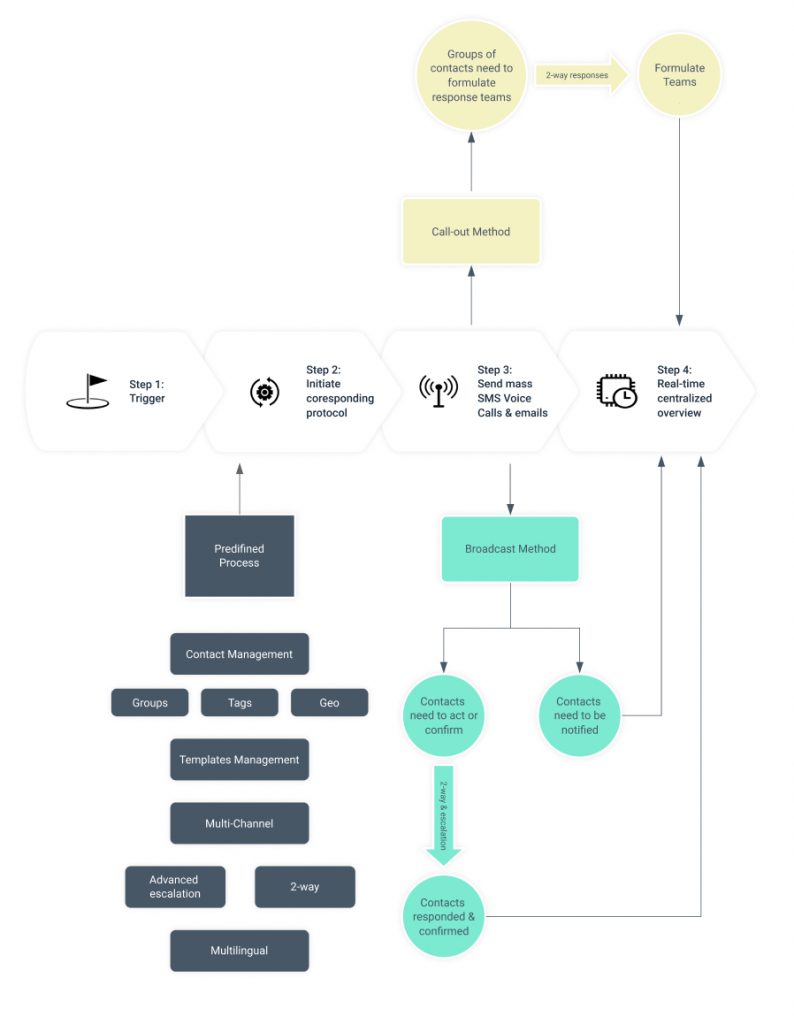The ability to communicate with your people efficiently during emergencies and operational disruptions is critical. It significantly affects how your organization resists an adverse event and how quickly it recovers when these events occur.
In this era of expansive connectivity it really shouldn’t be difficult – but often, it is. Sure, the tools are out there: emails, SMS, fixed lines, mobiles etc. But without a unified platform and established communications processes that match your response plans you can struggle to respond in a crisis. Instead misinformation, errors, and late response is the likely outcome.
To understand why mass notification technology is specifically designed to address emergencies and unexpected events, we created a diagram to explain what distinguishes it from other solutions in the market like bulk SMS services, newsletter or instant messaging platforms.

Step 1: Trigger
An incident triggers a response process. You never know where you will be when an incident occurs so mass notification platforms should offer multiple ways to initiate an incident. It is essential that you can trigger a response using a web platform or mobile app, by sending an SMS to a predefined number or even automatically: by integrating with a third-party system. Multiple options will ensure that appropriate action wil be taken under any circumstances.
Step 2: Initiate Protocol
The standard operating procedures of your organization will have a unique communication process that must be followed, depending on the exact nature of the event. It includes a set of specific information – an emergency protocol. Mass notification systems are an excellent way to automate these processes because they offer a set of tools that are specifically designed for emergency response. These tools include:
Contact Management system: This system enables the capture and storage of the contact details of the recipients that need to be reached immediately in case of a crisis. For better management, you must be able to group and tag your recipients (eg in departments, or by skills). It is also useful to be able to assign specific locations to staff members.
People might come and go or just move to different departments and locations. Keeping the contact details up to date can be a headache. Mass notification systems should support the import of contacts through csv files and integrate with third-party systems like Active Directory or LDAP.
In that way, when an incident occurs, by applying multiple filters on-the-fly or just graphically selecting a region on a map, you always make sure that only the right people will get notified.
Template management system: When an adverse event occurs, there is preciously little time to react. That is why it is essential to create notification templates in advance that reflect your response processes. Template management systems enable the storage of dynamic notifications that include all the necessary information you need to distribute with immediate effect. Where recipients speak different languages you should ensure your system supports different languages too.
With template management systems organizations ensure that the right message will be rapidly delivered as and when needed.
Multi-channel: Depending on the incident different channels might be required for effective communication. For example, the most critical incidents might be better communicated via voice calls, but it might make more sense to communicate a simple warning using SMS. That’s why mass notification systems should integrate multiple channels, such as voice, SMS, Viber, email or desktop notifications.
This flexibility is critical to design and implement different communication strategies that are effective for every incident and event.
Two-way: Custom response options for two-way communications is a core function for every mass notification system. It is simple: the initiator can define one or more options as answers for each notification sent. Next, the recipients select in their devices one of the options by pressing a key in response to a voice call. The response can also be sent using SMS or by tapping an embedded link to respond to an SMS or an email.
Two-way communication means you can get real-time feedback and assess situations more efficiently.
Advanced escalation: Two-way capability enables another core feature of mass notification technology: escalation logic. Let’s say a critical event occurs, and you need to reach a certain, set number of recipients. Using a mass notification system you can create a mechanism that forces notification dissemination to continue until a set logic is fulfilled. This can include sending notifications to alternative devices for multiple cycles or until the pre-set number of contacts acknowledges receipt. You can even define a next person in line, in case the first fails to respond.
Step 3: Send Notification
The system starts to reach contacts according to the protocol and does so via multiple communication channels. Including voice calls, SMS and emails. In the case of voice call communication, the system a mass notification system should automatically convert the text into speech.
Speed is essential, mass notification systems are created to guarantee fast and reliable dissemination of information to multiple thousands of recipients in a just a few minutes.
Initiators may utilize different communication methods according to the business case and specific requirements.
Broadcast Method: Broadcast method is the most common option, along with mass notification platforms. There are three types of broadcast methods.
The simple broadcast type is used when the only requirement is that the information reaches one or more of the devices for each recipient. This type is commonly used for minor incidents and to distribute information.
The two-way broadcast means that recipients are asked to respond by selecting one of several predefined answers. This method is usually used for medium critical incidents when you need to confirm that everyone is fine or to do quick damage assessments or polls. It is also used to just confirm everyone has read your message.
The two-way plus escalation broadcast is used for emergencies when you need to do everything to immediately reach your staff. To do so you ask for a response. If you do not get a response the notification is escalated to a different device or channel until the recipient is reached.
Call-out method: Using the callout method the initiator can request a certain maximum number of positive responses to a notification. Once the number of positive responses is received the notification process stops. This method is very useful when you need to formulate response teams to address an emergency or just need extra staff at extremely short notice.
Step 4: Real-time Overview
Real-time overview is the key to contain and control incidents efficiently. As your system begins to reach recipients, a central dashboard allows the sender to be able to track notification dissemination and recipient response statuses in real time


